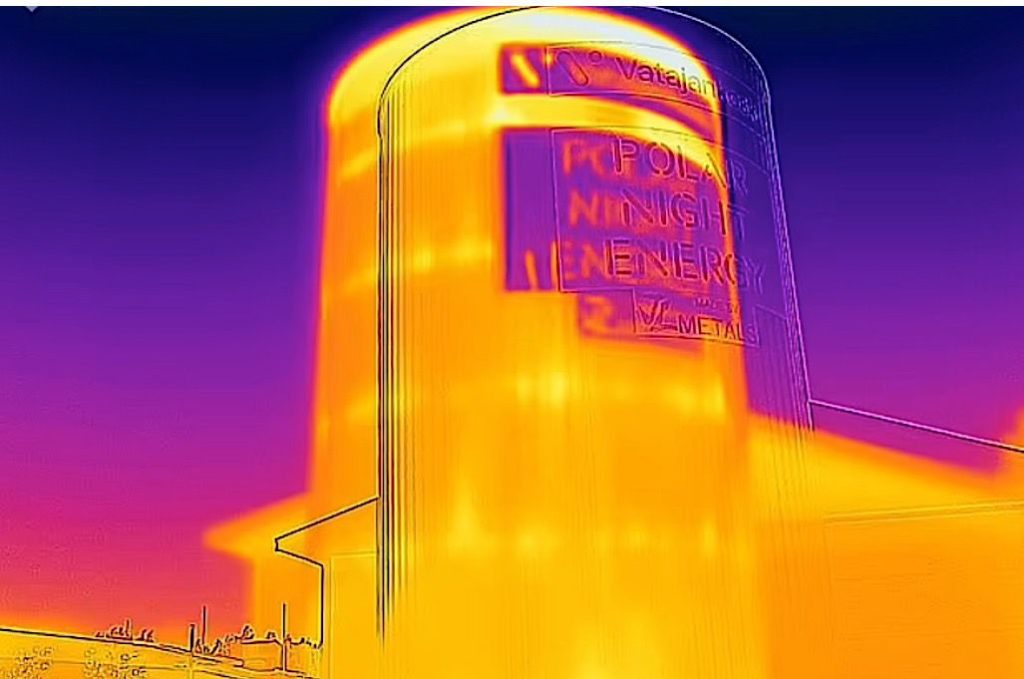The internet is hot for what’s being called a “sand battery.” In our earlier post about it, I was lukewarm. It looked like a form of seasonal thermal energy storage (STES), which has been done for decades, and that is pretty much how the Finnish designers described it on their website. The term “sand battery” seemed to have come from BBC reporter Matt McGrath, a clever coinage that made it sound like something different and new. And it is different and new, just not in the way everyone is talking about.
We sent some questions to the designers, and they had not responded at the time of writing of the post, but Polar Night Energy Chief Technology Officer Markku Ylönen apologized, noting that these are “crazy days” for them. He tells Treehugger:
“It is true that we have been trying to avoid the word battery, since technically speaking it is not what we have. Anyhow, the word caught fire, and was a big part of the media success, and it probably was McGrath’s invention. Of course if we were to generate electricity from the heat, it would at least act like a battery does: taking in electricity and giving back electricity.”
But strictly speaking, any device that stores energy produced at one time for use at another time can be described as a battery. I often call Passivhaus building designs “thermal batteries” because that’s what they can do; instead of wrapping sand in insulation as Polar Night Energy does, they wrap air. We have also described how an energy-efficient house can become a big wind-powered battery, where engineer Es Tressider proposed cranking up the heat when the wind blows. And really, even a lead-acid or lithium-ion battery doesn’t store electricity: It stores chemical energy that can be converted into electrical energy. So it is not a serious stretch to call it a form of battery.
The biggest difference with Polar Night Energy’s system is the extremely high temperature at which it is storing thermal energy—up to 1,000 degrees Celsius (1,832 degrees Fahrenheit), which is well over 10 times as high as most STES systems run at. There are good reasons why this isn’t usually done, the main one being: Where do you get the heat?
Hydrosolar, a Quebec-based company that has worked with STES. Ian Shulman, Hydrosolar’s technical sales manager, tells Treehugger:
“The benefit of going with lower temperature systems allows the same system (such as vacuum tube solar panels) to be used for space heating, domestic hot water without needing mixing valves, etc. Which does simplify the designs of the systems. The lower temperature design also allows you to have less insulation around the seasonal thermal storage (usually located under the house) which also drives the installation costs down.”
This is key. Cranking the heat up to a thousand degrees is not only counterintuitive, but it also goes against the basic principles of maximizing exergy—”the capacity of energy to do useful work.” They are cooking sand to high temperatures, which is ending up in a district heating system at one-tenth the temperature, using the highest-exergy sources for low exergy uses; it is what engineer Robert Bean called “warming your hands with a blowtorch.” The only reason that it makes any sense or anyone would actually do this is that the high-quality power source is essentially free—it is the excess electricity from solar energy collected in summer.
Ylönen clearly gets the exergy thing, and is hoping to use the system’s higher quality heat in other ways: “With high temperature comes high versatility: we want to offer the heat to industries, producing for example steam at 200 degrees C, or even to produce process heat at 400 degrees C or so. These processes are mostly fueled by gas and coal.”
Because of that high exergy, they actually could use it to generate electricity making it a true battery, although not very efficiently. Ylönen says they are looking at it.
“The high temperature of our storage would allow some reasonable efficiency for the electricity generation, but it still is economically challenging, as the efficiency would be in the order of 20%,” says Ylönen. “We’ve actually studied this quite far, but there’s enough to do on the heat side of things for the moment. Generating electricity from heat would be straightforward, just by adding an ORC [Organic Rankine Cycle] or a steam turbine, or even a gas turbine (maybe Stirling also, but I do not see much of them commercially available yet).”
Library of Congress / CC BY-SA 4.0
As we know from Aesop, it’s wise to take summer sunshine and store it away for winter. There are many ways to do this, but Ylönen, Tommi Eronen, and their team have figured out an interesting twist.
In the end, it is actually sort of a battery and much more than seasonal thermal energy storage as we know them. And while I was blasé and lukewarm before, I am definitely getting more excited, as it not only stores the energy but the exergy you get when you have lots of free electricity sitting around in summer. Aesop would approve.
